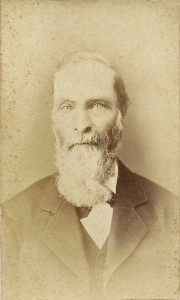Michael Fagan (b.1819 Malin, Co. Donegal, Ireland – d.1886 Lemont, IL)
Our story begins with Michael Fagan, who, at the age of 18, left Ireland in the spring of 1837. He answered a recruitment call for laborers in “Americay” on the Wabash and Erie Canal in Indiana posted by James Corscaden & Company, 26 Shipquay Street, Derry.

Michael Fagan c.1871
He set sail from Derry aboard the 401-ton British Barque JOHN STAMP of Newcastle, England, on April 7th along with 159 other passengers, of whom at least 39 were listed as “laborours” on the ship’s manifest. Landing in Philadelphia on June 23rd, Michael joined several other shipmates from Tyrone, Derry, and Leitrim, and they made their way westward to Williamsport, Indiana, to seek fame and fortune on one of the many internal improvement projects within the fledgling state.
But Michael soon found the conditions in the prairie labor camps brutal, dangerous, and full of disease. As the months passed he grew increasingly homesick. Shared hardships and difficulty adapting to new surroundings fueled animosity among the Irish within the camps and spawned violence between two organized immigrant secret societies – the Corkonians and the Fardowns. These provincial factions were originally formed in Ireland and they had carried their bigotry across the Atlantic to America, where each group ruthlessly defended the economic interests of their fellow members. These itinerant groups met with violence any and all obstacles that they felt were a threat to their employment or wages. Camp brawls and riots were commonplace. Some uprisings were small; others were large-scale battles resulting in injuries and deaths and required militia involvement to restore order. These frequent conflicts arose throughout the state and caused several disruptions in the construction of canals and railroads between 1835-1837. They came to be known as the “Indiana Irish Wars” and spread wherever the Irish labor force went, leading to a deep and long-standing fear and hatred of Irish Catholics among local non-Irish citizenry.
Although he hailed from County Donegal, young and naïve Michael Fagan found it impossible to survive without aligning with the Fardowns, that in Indiana at least, were mostly from the provinces of Connacht and Leinster.
His letter home in 1838 makes no references to the difficulties Michael had adapting to his new home. Reading between the lines one can only speculate how much more difficult life must have been back in Ireland. Despite the hardships he endured in America, he didn’t want to worry his aged mother.

